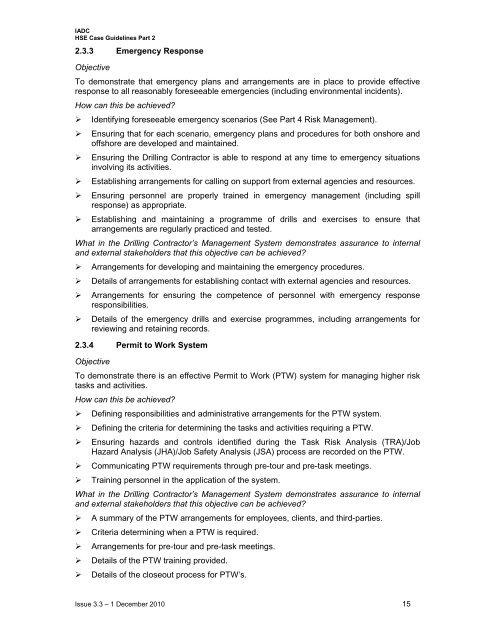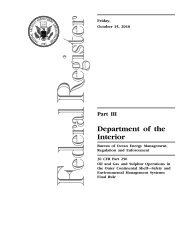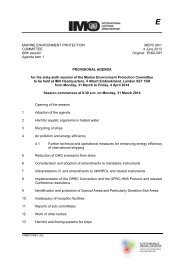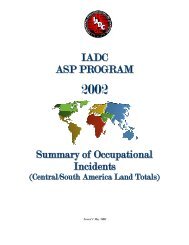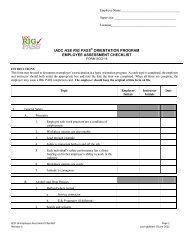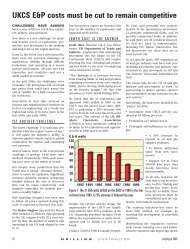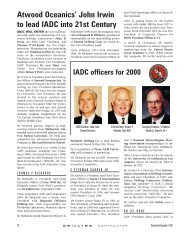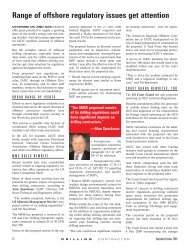Download Offshore HSE Case Guidelines - IADC
Download Offshore HSE Case Guidelines - IADC
Download Offshore HSE Case Guidelines - IADC
Create successful ePaper yourself
Turn your PDF publications into a flip-book with our unique Google optimized e-Paper software.
<strong>IADC</strong><br />
<strong>HSE</strong> <strong>Case</strong> <strong>Guidelines</strong> Part 2<br />
2.3.3 Emergency Response<br />
Objective<br />
To demonstrate that emergency plans and arrangements are in place to provide effective<br />
response to all reasonably foreseeable emergencies (including environmental incidents).<br />
How can this be achieved?<br />
‣ Identifying foreseeable emergency scenarios (See Part 4 Risk Management).<br />
‣ Ensuring that for each scenario, emergency plans and procedures for both onshore and<br />
offshore are developed and maintained.<br />
‣ Ensuring the Drilling Contractor is able to respond at any time to emergency situations<br />
involving its activities.<br />
‣ Establishing arrangements for calling on support from external agencies and resources.<br />
‣ Ensuring personnel are properly trained in emergency management (including spill<br />
response) as appropriate.<br />
‣ Establishing and maintaining a programme of drills and exercises to ensure that<br />
arrangements are regularly practiced and tested.<br />
What in the Drilling Contractor’s Management System demonstrates assurance to internal<br />
and external stakeholders that this objective can be achieved?<br />
‣ Arrangements for developing and maintaining the emergency procedures.<br />
‣ Details of arrangements for establishing contact with external agencies and resources.<br />
‣ Arrangements for ensuring the competence of personnel with emergency response<br />
responsibilities.<br />
‣ Details of the emergency drills and exercise programmes, including arrangements for<br />
reviewing and retaining records.<br />
2.3.4 Permit to Work System<br />
Objective<br />
To demonstrate there is an effective Permit to Work (PTW) system for managing higher risk<br />
tasks and activities.<br />
How can this be achieved?<br />
‣ Defining responsibilities and administrative arrangements for the PTW system.<br />
‣ Defining the criteria for determining the tasks and activities requiring a PTW.<br />
‣ Ensuring hazards and controls identified during the Task Risk Analysis (TRA)/Job<br />
Hazard Analysis (JHA)/Job Safety Analysis (JSA) process are recorded on the PTW.<br />
‣ Communicating PTW requirements through pre-tour and pre-task meetings.<br />
‣ Training personnel in the application of the system.<br />
What in the Drilling Contractor’s Management System demonstrates assurance to internal<br />
and external stakeholders that this objective can be achieved?<br />
‣ A summary of the PTW arrangements for employees, clients, and third-parties.<br />
‣ Criteria determining when a PTW is required.<br />
‣ Arrangements for pre-tour and pre-task meetings.<br />
‣ Details of the PTW training provided.<br />
‣ Details of the closeout process for PTW’s.<br />
Issue 3.3 – 1 December 2010 15


